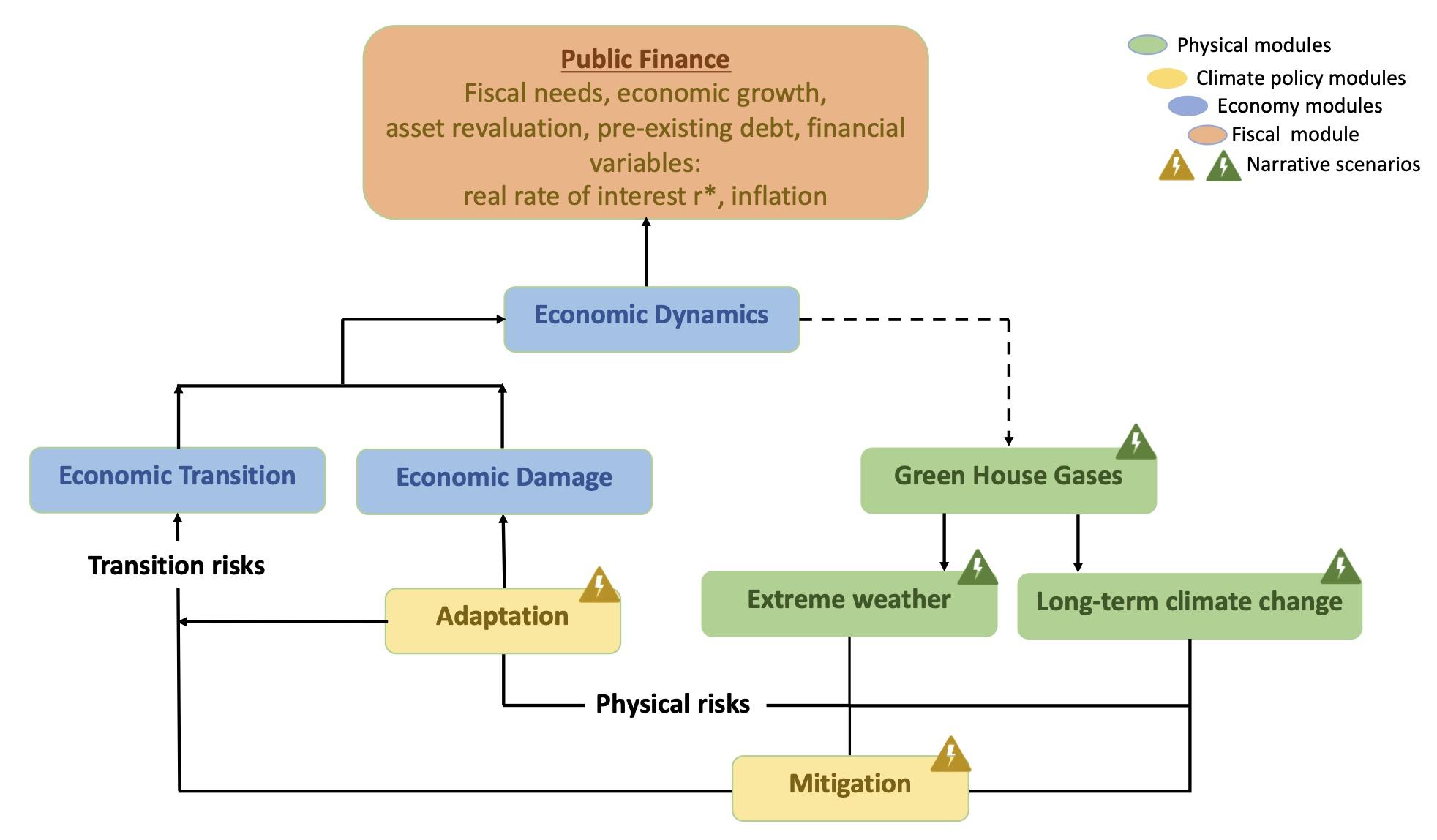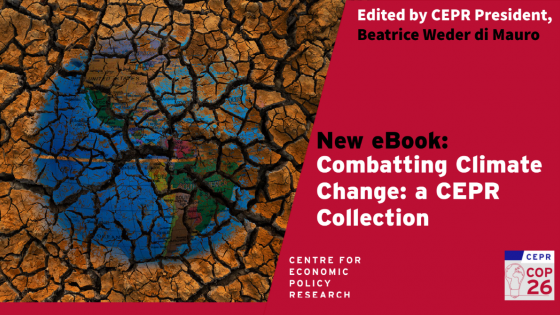Bold (and costly) climate action is required during the current decade, but at the same time, sovereign debt has reached levels not seen since WWII. Unprecedented central bank interventions during the pandemic have averted a debt crisis, but concerns are voiced that climate change imperils the ability of countries to repay Covid-19 debts (Dibley et al. 2021). These concerns go to the heart of the hypothetical proposal by Greta Thunberg, suggested by Kotlikoff et al. (2021) when they put words in her mouth for a bargain deal at the 2019 address to the United Nations:
“Since we cannot count on you to act morally, let me propose bribing you to save the planet. Adopt a high global carbon tax. However, cut other taxes so, on balance, you are better off. My and future generations will pay higher taxes to service the deficits you run.”
But can Greta’s cohort service the debts they inherit, given the climate effects on debt?
The CEPR collection (Di Mauro 2021) provides a “fascinating insight into the evolution of economic research on climate change over the last decade”. Climate risks to financial stability take centre stage, next to carbon pricing and green finance. Climate risks to fiscal stability attract scant attention, with only Persaud (2021) dealing with debt. A 2019 survey of the EU national fiscal councils found that their quantitative analyses do not cover climate risks. A Google trends search since the Paris Agreement has an average rating of 92 for “climate risks + financial” and 36 for “+ fiscal”. Google Scholar lists 1.94 million documents on the former topic and 0.3 million on the latter. Cognisant of the challenges ahead, the European Fiscal Board recently asked for a holistic view of climate risks to fiscal planning (Thygesen et al. 2022).
In Zenios (2022), I suggest developing such a holistic view by capitalising on advances in climate risk and debt sustainability analysis (DSA). Combining narrative scenarios of climate analysis (Climatic Change 2014) with scenario trees from stochastic DSA, I argue that we can link integrated assessment models (IAM), pioneered by Nordhaus, with DSA to inform our understanding of climate effects on debt.
Channels from climate change to sovereign debt
Climate change impacts sovereign debt through multiple channels: economic growth, acute and chronic damages, and costs from low carbon transition (Figure 1).
Figure 1 From climate change to public finance
Let us look at indicative magnitudes. A Tol (2014) meta-analysis finds that a 5°C temperature rise could adversely impact the world economy by 3 to 15% of GDP. The impact would be 2.5% under a 2.5°C increase, although some regions suffer more (15% for the tropics). Damages are documented in international disasters databases but extrapolating from history underestimates future damages as the number and severity of extreme events accelerate; EM-DAT reports a doubling of events from 1985 to recent years. Losses from severe weather for European countries are projected to grow by €170 billion p.a. (1.4% GDP).1 Transitioning from fossil fuels also causes sovereign wealth to be repriced, with assets worth $12 trillion (3% of the capital stock) estimated to be stranded by 2050 (Banque de France 2019).
The bond markets are pricing climate risks (Cevik and Tovar-Jalles 2020), and rating agencies anticipate that climate change will affect ratings in the coming decades. Klusak et al. (2021) find that 55 sovereigns face downgrades under a 2°C increase and eighty under 4.2°C, with concomitant increases in debt servicing costs.
Putting the pieces together suggests that unchecked climate change could precipitate a ‘climate-debt doom loop’. Increasing debt servicing costs add to the costs from damages and climate policies, and the compounded effects can become a first-order problem for some sovereigns. Indeed, countries with greater exposure to climate risks have more precarious public debt positions: the climate-vulnerable EU tercile averages a debt of 133% of GDP compared to 78% for the least vulnerable. If climate costs raise concerns about the ability to repay, the sovereign is downrated, and its financing rates go up. The sovereign is caught in a debt trap that can be difficult to escape if climate change lowers growth. Greta’s cohort will be in a bind.
Debt sustainability analysis with climate risk
DSA with a climate module can assess the risk of such a trap. It tells us if a sovereign can sustainably finance its debt or estimates the available fiscal space if the debt is sustainable. These answers go to the heart of Thunberg’s hypothetical proposal. To assess whether future generations could service the debts, we need to weigh the debt created by today’s policies and the climate effects on debt. Linking IAM with DSA allows for structured dialogue on this complex issue.
The DSA of Zenios et al. (2021) uses scenario trees to represent future uncertain GDP growth, government primary balance, and interest rates. Debt-to-GDP ratios are stochastic variables on the tree. A tail risk measure tells us if the debt remains on a non-increasing path with high probability so that it is deemed sustainable with high confidence. If the debt declines, we can estimate the available space to run more deficits ‘to save the planet’.
Presently, DSA scenarios ignore climate risks and extend over medium horizons when experts’ projections are reliable, with probabilities calibrated to market data. Beyond that, scenarios converge to long-term trends, such as the historical average growth or inflation target. The analysis of climate risks, on the other hand, is complicated by deep uncertainty. There is ambiguity where outcomes may be known, but their likelihood is not, and there are misspecifications with no consensus on models.
It is possible to deal with this complexity, even if not with high precision. Climate scientists postulate possible future states of the world, but they cannot pin down probabilities as future conditions depend on unknown policy paths. To integrate climate risk into DSA, we calibrate scenario trees on IAM economic projections under future states. To deal with the ambiguity about future conditions, we build on the work of the Integrated Assessment Consortium (IAC).2
IAC developed a narrative scenario architecture (Climatic Change 2014) that combines representative concentration pathways (RCPs) of atmospheric greenhouse gases with narratives on shared socioeconomic pathways (SSPs). Table 1 illustrates the scenario architecture. For each cell, the number of available IAM can generate projections and using ensembles of models, we deal with model misspecification.
The scenario architecture provides transparent states of the world for what-if analyses. For each SSP-RCP pair, existing IAM provide forward-looking projections of mitigation and adaptation costs, damages, GDP growth, and other outcomes to integrate climate risks into DSA.
Table 1 Narrative scenario architecture of climate risks
I present the case study for Italy, using growth projections from two prominent IAM to showcase the climate effects on debt and the challenge of misspecifications.3
Figure 2 shows the 25/75 quantiles of debt dynamics with climate-free DSA using projections from the IMF World Economic Outlook and the ECB, with volatilities and correlations matching their historical values. The median debt is stable with significant upside risk. I then introduce climate effects consistent with the Paris Agreement (RCP2.6-SSP2) using the WITCH model (Emmerling et al. 2016) and RICE50+ (Gazzotti et al. 2021). Both models project downward adjustments to Italy’s growth, and I use these projections to re-calibrate the trees. The climate-adjusted DSA results are overlayed onto the fan chart of Figure 2, and we observe deteriorating debt dynamics. With RICE50+, the effects kick in from 2050, whereas WITCH changes are noticeable from the mid-2030s. We note an accelerating trend after mid-century due to increasing adverse climate effects and the nonlinear increase in risk premia as a manifestation of the doom loop.
Figure 2 Dynamics of Italian debt stock with climate impact on growth
Climate‑proofing public finance
Governments need to prepare public finance for climate change:
- Climate challenges are global (or regional) and require coordination. A coordinated modelling effort using the scenario architecture will deliver transparency and ensure the acceptability of scenarios for fiscal planning. A network for climate-proofing public finance could play the coordinating role.
- Fiscal authorities should mainstream climate risk analysis in public finance. Budgetary plans should include damages and the costs of mitigation and adaptation, including social costs, perhaps as contingent liabilities, and seek risk-sharing instruments that provide fiscal space during weather shocks (Demertzis and Zenios 2019).
- Fiscal authorities should disclose their exposures following the Task Force on Climate-related Financial Disclosures guidelines. The resilience of a country’s debt to climate change is essential, whether the country is contributing a lot or a little to climate change.
It is not up to any single country to mitigate climate change. But it is up to the fiscal stability institutions to ensure that the budgetary position of sovereigns is resilient.
References
Banque de France (2019), “Benchmarks for the financial sector in the face of climate risk: facts and recommendations”, Financial Stability Review 23.
Cevik, S and J Tovar-Jalles (2020), “This changes everything: climate shocks and sovereign bonds”, International Monetary Fund Working Paper.
Climatic Change (2014), “Special issue: a framework for the development of new socioeconomic scenarios for climate change research”, Climatic Change 122(3).
Demertzis, M and S A Zenios (2019), “State contingent debt as insurance for euro area sovereigns”, Journal of Financial Regulation 5(1): 64–90.
Dibley, A, T Wetzer and C Hepburn (2021), “National COVID debts: climate change imperils countries’ ability to repay”, Nature 592: 184–187.
Di Mauro, B W (2021), Combatting Climate Change: A: CEPR Collection, CEPR Press, 8 November.
Emmerling, J, L Drouet, L A Reis, M Bevione, L Berger, V Bosetti, S Carrara, E De Cian, G D M D'Aertrycke, T Longden and M Malpede (2016), “The WITCH 2016 model-documentation and implementation of the shared socioeconomic pathways”, Fondazione Eni Enrico Mattei Working Paper.
Gazzotti, P, J Emmerling G Marangoni, A Castelletti, K van der Wijst, A Hof and M Tavoni (2021), “Persistent inequality in economically optimal climate policies”, Nature Communications 12(1): 1-10.
Klusak, P, M Agarwal, M Burke, M Kraemer and K Mohaddes (2021), “Rising temperatures, falling ratings: the effect of climate change on sovereign creditworthiness”, University of Cambridge Working Paper.
Tol, R S J (2014), “Correction and update: the economic effects of climate change”, Journal of Economic Perspectives 28(2): 221–226.
Zenios S A, A Consiglio, M Athanasopoulou, E Moshammer, A Gavilan and A Erce (2021), “Risk management for sustainable sovereign debt financing”, Operations Research 69(3): 755–773.
Zenios, S A (2022), “The risks from climate change to sovereign debt”, Climatic Change 172(3): 1-19, first published as Bruegel Policy Contribution No. 16/21, July 2021, Bruegel, Brussels.
Endnotes
1 PESETA IV project (https://ec.europa.eu/jrc/en/peseta-iv/economic-impacts)
2 This is a scientific consortium established in 2007 in response to a call from the Intergovernmental Panel on Climate Change (IPCC), see https://www.iamconsortium.org.
3 Caveat emptor: This case study should not be construed as a complete debt sustainability analysis for Italy. It illustrates what is possible, and in Zenios (2022) I discuss what additional work is needed and is possible by combining DSA with IAM.






